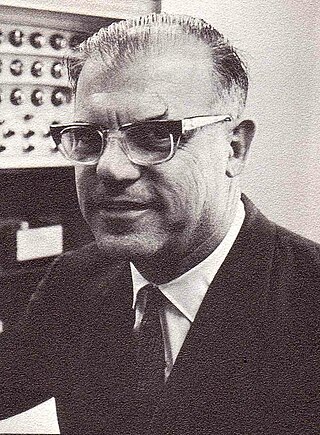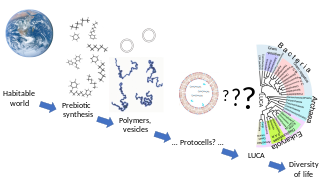
Amino acids are organic compounds that contain both amino and carboxylic acid functional groups. Although over 500 amino acids exist in nature, by far the most important are the alpha-amino acids, which comprise proteins. Only 22 alpha amino acids appear in the genetic code.

The Miller–Urey experiment (or Miller experiment) is a famous chemistry experiment that simulated the conditions thought at the time (1952) to be present in the atmosphere of the early, prebiotic Earth, in order to test the hypothesis of the chemical origin of life under those conditions. The experiment used water (H2O), methane (CH4), ammonia (NH3), hydrogen (H2), and an electric arc (the latter simulating hypothesized lightning).

Proteins are large biomolecules and macromolecules that comprise one or more long chains of amino acid residues. Proteins perform a vast array of functions within organisms, including catalysing metabolic reactions, DNA replication, responding to stimuli, providing structure to cells and organisms, and transporting molecules from one location to another. Proteins differ from one another primarily in their sequence of amino acids, which is dictated by the nucleotide sequence of their genes, and which usually results in protein folding into a specific 3D structure that determines its activity.

The RNA world is a hypothetical stage in the evolutionary history of life on Earth, in which self-replicating RNA molecules proliferated before the evolution of DNA and proteins. The term also refers to the hypothesis that posits the existence of this stage.
Synthesis or synthesize may refer to:
The iron–sulfur world hypothesis is a set of proposals for the origin of life and the early evolution of life advanced in a series of articles between 1988 and 1992 by Günter Wächtershäuser, a Munich patent lawyer with a degree in chemistry, who had been encouraged and supported by philosopher Karl R. Popper to publish his ideas. The hypothesis proposes that early life may have formed on the surface of iron sulfide minerals, hence the name. It was developed by retrodiction from extant biochemistry in conjunction with chemical experiments.

Proteinogenic amino acids are amino acids that are incorporated biosynthetically into proteins during translation. The word "proteinogenic" means "protein creating". Throughout known life, there are 22 genetically encoded (proteinogenic) amino acids, 20 in the standard genetic code and an additional 2 that can be incorporated by special translation mechanisms.

Alexander Ivanovich Oparin was a Soviet biochemist notable for his theories about the origin of life, and for his book The Origin of Life. He also studied the biochemistry of material processing by plants and enzyme reactions in plant cells. He showed that many food production processes were based on biocatalysis and developed the foundations for industrial biochemistry in the USSR.

Sidney Walter Fox was a Los Angeles-born biochemist responsible for discoveries on the origins of biological systems. Fox explored the synthesis of amino acids from inorganic molecules, the synthesis of proteinous amino acids and amino acid polymers called "proteinoids" from inorganic molecules and thermal energy, and created what he thought was the world's first protocell out of proteinoids and water. He called these globules "microspheres". Fox believed in the process of abiogenesis where life spontaneously organized itself from the colloquially known "primordial soup;" poolings of various simple organic molecules that existed during the time before life on Earth. He also suggested that his experiments possessed conditions that were similar to those of primordial Earth.

Coacervate is an aqueous phase rich in macromolecules such as synthetic polymers, proteins or nucleic acids. It forms through liquid-liquid phase separation (LLPS), leading to a dense phase in thermodynamic equilibrium with a dilute phase. The dispersed droplets of dense phase are also called coacervates, micro-coacervates or coacervate droplets. These structures draw a lot of interest because they form spontaneously from aqueous mixtures and provide stable compartmentalization without the need of a membrane.
Microparticles are particles between 0.1 and 100 μm in size. Commercially available microparticles are available in a wide variety of materials, including ceramics, glass, polymers, and metals. Microparticles encountered in daily life include pollen, sand, dust, flour, and powdered sugar.
Protein metabolism denotes the various biochemical processes responsible for the synthesis of proteins and amino acids (anabolism), and the breakdown of proteins by catabolism.

Carboxypeptidase A usually refers to the pancreatic exopeptidase that hydrolyzes peptide bonds of C-terminal residues with aromatic or aliphatic side-chains. Most scientists in the field now refer to this enzyme as CPA1, and to a related pancreatic carboxypeptidase as CPA2.

A protocell is a self-organized, endogenously ordered, spherical collection of lipids proposed as a stepping-stone toward the origin of life. A central question in evolution is how simple protocells first arose and how they could differ in reproductive output, thus enabling the accumulation of novel biological emergences over time, i.e. biological evolution. Although a functional protocell has not yet been achieved in a laboratory setting, the goal to understand the process appears well within reach.

In biology, abiogenesis or the origin of life is the natural process by which life has arisen from non-living matter, such as simple organic compounds. The prevailing scientific hypothesis is that the transition from non-living to living entities on Earth was not a single event, but a process of increasing complexity involving the formation of a habitable planet, the prebiotic synthesis of organic molecules, molecular self-replication, self-assembly, autocatalysis, and the emergence of cell membranes. Many proposals have been made for different stages of the process.

Evolution of cells refers to the evolutionary origin and subsequent evolutionary development of cells. Cells first emerged at least 3.8 billion years ago approximately 750 million years after Earth was formed.

In biochemistry, non-coded or non-proteinogenic amino acids are distinct from the 22 proteinogenic amino acids which are naturally encoded in the genome of organisms for the assembly of proteins. However, over 140 non-proteinogenic amino acids occur naturally in proteins and thousands more may occur in nature or be synthesized in the laboratory. Chemically synthesized amino acids can be called unnatural amino acids. Unnatural amino acids can be synthetically prepared from their native analogs via modifications such as amine alkylation, side chain substitution, structural bond extension cyclization, and isosteric replacements within the amino acid backbone. Many non-proteinogenic amino acids are important:

Jeewanu are synthetic chemical particles that possess cell-like structure and seem to have some functional properties; that is, they are a model of primitive cells, or protocells. It was first synthesised by Krishna Bahadur, an Indian chemist and his team in 1963. Using photochemical reaction, they produced coacervates, microscopic cell-like spheres from a mixture of simple organic and inorganic compounds. Bahadur named these particles 'Jeewanu' because they exhibit some of the basic properties of a cell, such as the presence of semipermeable membrane, amino acids, phospholipids and carbohydrates. Further, like living cells, they had several catalytic activities. Jeewanu are cited as models of protocells for the origin of life, and as artificial cells.
GADV-protein world is a hypothetical stage of abiogenesis. GADV stands for the one letter codes of four amino acids, namely, glycine (G), alanine (A), aspartic acid (D) and valine (V), the main components of GADV proteins. In the GADV-protein world hypothesis, it is argued that the prebiotic chemistry before the emergence of genes involved a stage where GADV-proteins were able to pseudo-replicate. This hypothesis is contrary to the RNA world hypothesis.
A scenario is a set of related concepts pertinent to the origin of life (abiogenesis), such as the iron-sulfur world. Many alternative abiogenesis scenarios have been proposed by scientists in a variety of fields from the 1950s onwards in an attempt to explain how the complex mechanisms of life could have come into existence. These include hypothesized ancient environments that might have been favourable for the origin of life, and possible biochemical mechanisms.










